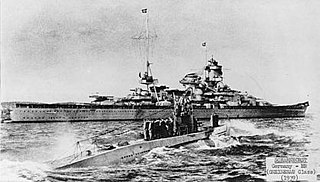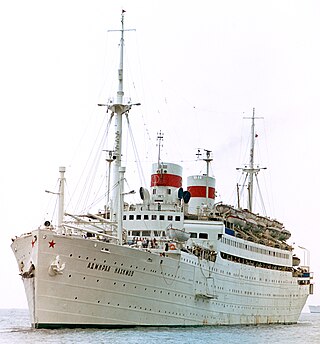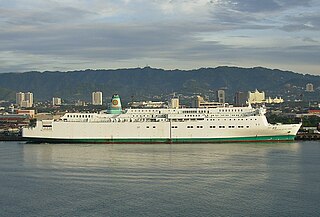Related Research Articles

USS Bowfin (SS/AGSS-287), is a Balao-class submarine of the United States Navy named for the bowfin fish. Since 1981, she has been open to public tours at the USS Bowfin Submarine Museum & Park in Pearl Harbor, Hawaii, next to the USS Arizona Memorial Visitor Center.

German submarine U-47 was a Type VIIB U-boat of Nazi Germany's Kriegsmarine during World War II. She was laid down on 25 February 1937 at Friedrich Krupp Germaniawerft in Kiel as yard number 582 and went into service on 17 December 1938 under the command of Günther Prien.

SS Admiral Nakhimov, launched in March 1925 and originally named SS Berlin, was a passenger liner of the German Weimar Republic later converted to a hospital ship, then a Soviet passenger ship. On 31 August 1986, Admiral Nakhimov collided with the large bulk carrier Pyotr Vasev in the Tsemes Bay, near the port of Novorossiysk, Russian SFSR, and quickly sank. In total, 423 of the 1,234 people on board died.

SS Carl D. Bradley was an American self-unloading Great Lakes freighter that sank in a Lake Michigan storm on November 18, 1958. Of the 35 crew members, 33 died in the sinking. Twenty-three were from the port town of Rogers City, Michigan, United States. Her sinking was likely caused by structural failure from the brittle steel used in her construction as well as extensive use throughout her 31-year career.

The MS al-Salam Boccaccio 98 was an Egyptian Ro/Ro passenger ferry, operated by El Salam Maritime Transport, that sank on 3 February 2006 in the Red Sea en route from Duba, Saudi Arabia, to Safaga in southern Egypt.

SS Daniel J. Morrell was a 603-foot (184 m) Great Lakes freighter that broke up in a strong storm on Lake Huron on 29 November 1966, taking with her 28 of her 29 crewmen. The freighter was used to carry bulk cargoes such as iron ore but was running with only ballast when the 60-year-old ship sank. When built in 1906, she was the "Queen of the Lakes", being the longest ship then in service on the Great Lakes.

The Salem Express was a passenger ship that sank in the Red Sea. It is notable due to the heavy loss of life which occurred when she sank shortly after striking a reef at around 11:13pm on Saturday December 14, 1991.
M/V Pool Fisher was a British merchant vessel that sank off the Isle of Wight on 6 November 1979 with the loss of most of her crew.

MV Princess of the Stars was a passenger ferry owned by Filipino shipping company Sulpicio Lines, that capsized and sank on June 21, 2008, off the coast of San Fernando, Romblon at the height of Typhoon Fengshen, which was locally named by PAGASA as Frank. The storm passed directly over Romblon as a Category 2 typhoon, leading to the capsizing of the vessel; 814 people died as a result of the disaster.

The lake freighter SS Henry Steinbrenner was a 427-foot (130 m) long, 50-foot (15 m) wide, and 28-foot (8.5 m) deep, dry bulk freighter of typical construction style for the early 1900s, primarily designed for the iron ore, coal, and grain trades on the Great Lakes. Commissioned by the Kinsman Transit Co. of Cleveland, Ohio she was launched as hull number 14 by Jenks Ship Building Co. of Port Huron, Michigan. Her design featured a forward forecastle containing crew cabins topped with an additional cabin and pilot house. The mid section was a long nearly flat deck over the cargo holds only interrupted by 12 hatches fitted with telescoping type hatch covers. The aft end featured a large cabin situated over the engine room containing the galley, mess rooms, and crew quarters and was topped with a smoke stack and air vents. The Steinbrenner later featured a "doghouse" cabin aft of her smoke stack to house added crew from a change in the crew watch system on the Great Lakes.

SS Cedarville was a bulk carrier that carried limestone on the Great Lakes in the mid-20th century until it sank after a collision with another ship, MV Topdalsfjord on May 7, 1965.
MV Putney Hill was a cargo ship completed by William Doxford & Sons Ltd in Sunderland in 1940. She was owned by Putney Hill Steamships Co Ltd and managed by Counties Ship Management Co Ltd of London (CSM), both of which were offshoots of the Rethymnis & Kulukundis shipbroking company. Putney Hill was a sister ship of MV Tower Grange, which Doxford built in the same year for another CSM company, Tower Steamships Co Ltd.
Adriatica was a bulk carrier that sank in the Mediterranean Sea on December 12, 2010.

The vessel MV Blythe Star was a coastal freighter which foundered off south-western Tasmania in October 1973. The crew of 10 successfully took to a small inflatable liferaft but drifted undiscovered. A search for the ship and its crew led to the largest maritime search operation conducted in Australia to that time.
MV Volgo-Balt 214 was a Panama-flagged Ukrainian general cargo ship, which sank in the Black Sea off the coast of Samsun, Turkey on 7 January 2019. Six of the thirteen crew members on board died while seven of them were rescued by the Turkish authorities and taken to hospital.
References
- 1 2 3 "ARVIN, General Cargo Ship - Details and current position - IMO 8874316 - VesselFinder". www.vesselfinder.com. Retrieved 27 July 2023.
- ↑ MV Arvin Moment of breaking of the ship (Video) #shipwrecks #Ship_Accident, 17 January 2021, retrieved 27 July 2023
- ↑ "Video: Six Dead After Soviet-Era Freighter Sinks in Black Sea". The Maritime Executive. Retrieved 27 July 2023.
- ↑ ERR, BNS | (11 March 2021). "Estonian-owned cargo vessel sinks in Black Sea, at least two dead". ERR. Retrieved 27 July 2023.
- ↑ "Questions raised over carrier sinking within sight of land and two". Freight News. 5 February 2021. Retrieved 27 July 2023.
- 1 2 3 4 "ARVIN MMC Casualty Investigation Report" (PDF). www.palaureg.com. 1 March 2021. Archived (PDF) from the original on 2 December 2022. Retrieved 27 July 2023.